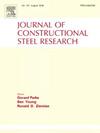考虑荷载比的SS275结构钢火灾后残余屈服强度和极限强度
IF 4
2区 工程技术
Q1 CONSTRUCTION & BUILDING TECHNOLOGY
引用次数: 0
摘要
火灾是钢结构最主要的危害之一。对于暴露在火灾中的钢结构,在拆除之前评估可重用性和可靠性对于确定最具成本效益的行动方案至关重要——是重新使用、修复、加强,还是拆除和重建。本研究建立了火灾暴露钢的剩余强度指标,这对于评估拆卸前的结构状况至关重要。在韩国建筑中广泛使用的SS275钢进行了火灾试验,模拟了在加热和冷却阶段施加恒定载荷的真实火灾情景。试验温度分别为540℃、650℃和900℃,考虑到许用应力和安全因素,载荷比最高可达30%。SS275的残余强度随暴露温度和载荷比的变化而变化。在540℃时,当载荷比从0%增加到30%时,残余屈服强度增加了13%,而对残余极限抗拉强度的影响最小。然而,在650℃时,将载荷比从0%提高到20%,残余屈服强度降低20%,极限抗拉强度降低19%。结果与先前的结构钢研究结果进行了比较,突出了火灾暴露时应力水平对火灾后残余强度的影响。这些指标为结构工程师提供了重要的数据,使他们能够在火灾损坏的钢结构的再利用、修复或拆除方面做出安全和具有成本效益的决定。本文章由计算机程序翻译,如有差异,请以英文原文为准。
Post-fire residual yield strength and ultimate strength of structural steel SS275 considering load ratios
Fire is one of the most significant hazards to steel structures. For fire-exposed steel structures, assessing reusability and reliability before dismantling is crucial to determine the most cost-effective course of action—whether to reuse, repair, strengthen, or demolish and rebuild. This study establishes indicators of residual strength for fire-exposed steel, essential for evaluating structural conditions prior to dismantling. Fire tests were conducted on SS275 steel, widely used in South Korean construction, simulating real fire scenarios with constant loads applied during heating and cooling phases. Test temperatures were 540 °C, 650 °C, and 900 °C, with load ratios up to 30 %, considering allowable stress and safety factors. The residual strength of SS275 varied with exposure temperature and load ratio. At 540 °C, residual yield strength increased by up to 13 % as the load ratio increased from 0 % to 30 %, with minimal impact on residual ultimate tensile strength. However, at 650 °C, raising the load ratio from 0 % to 20 % reduced the residual yield strength by up to 20 % and ultimate tensile strength by 19 %. Results were compared with previous studies on structural steels, highlighting the influence of stress levels during fire exposure on post-fire residual strength. These indicators provide critical data for structural engineers to make safe and cost-effective decisions regarding the reuse, repair, or dismantling of fire-damaged steel structures.
求助全文
通过发布文献求助,成功后即可免费获取论文全文。
去求助
来源期刊

Journal of Constructional Steel Research
工程技术-工程:土木
CiteScore
7.90
自引率
19.50%
发文量
550
审稿时长
46 days
期刊介绍:
The Journal of Constructional Steel Research provides an international forum for the presentation and discussion of the latest developments in structural steel research and their applications. It is aimed not only at researchers but also at those likely to be most affected by research results, i.e. designers and fabricators. Original papers of a high standard dealing with all aspects of steel research including theoretical and experimental research on elements, assemblages, connection and material properties are considered for publication.
 求助内容:
求助内容: 应助结果提醒方式:
应助结果提醒方式:


